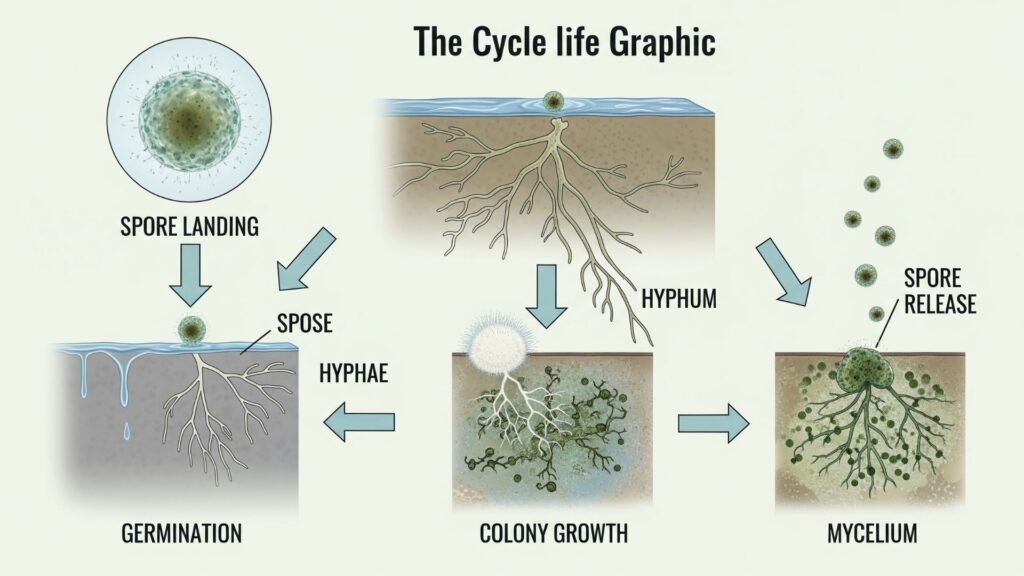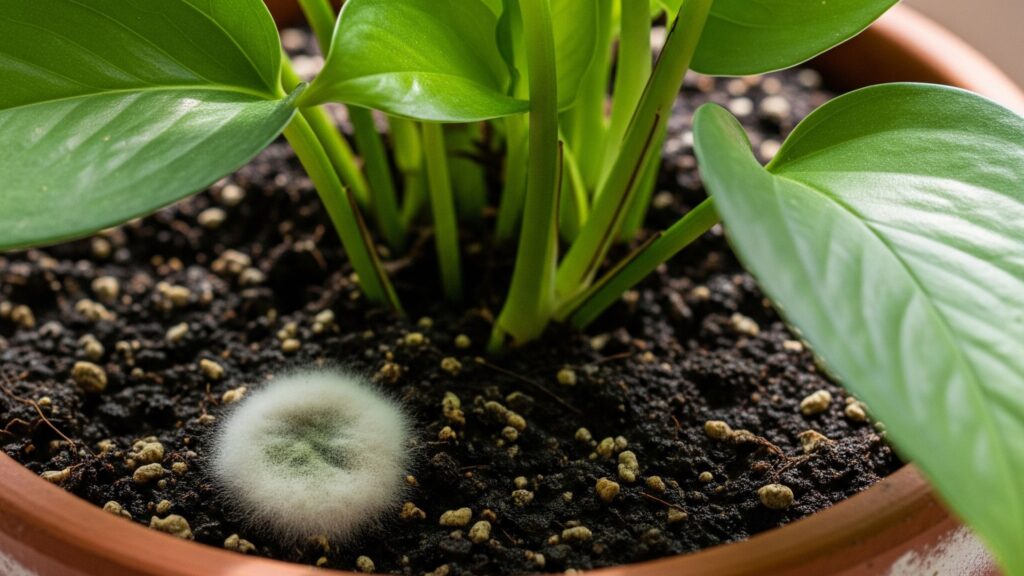Mold on Houseplant Soil: Addressing & Preventing Growth
What is That White Fuzzy Stuff on My Plant’s Soil?
As a homeowner in Los Angeles, you take pride in your property, including the vibrant houseplants that bring life to your indoor spaces. So, when you spot a fuzzy, white layer developing on the soil of your favorite fiddle-leaf fig or succulent, it’s natural to be concerned. This common sight is typically a type of saprophytic mold.
While it primarily feeds on decaying organic materials within the potting mix, its presence raises important questions. Is it just a plant problem, or could it be a sign of a larger issue within your home? At Mold Zero, we believe in empowering property owners with knowledge. Understanding why this mold appears is the first step in addressing it and ensuring your indoor environment is well-maintained.
The Conditions That Encourage Fungus on Plant Soil
The appearance of mold on houseplant soil is not random; it’s a direct result of a specific environment. This fungus thrives in conditions that are often created by well-meaning plant care routines. The primary culprit is excessive moisture. When soil remains damp for extended periods due to overwatering or poor drainage, it becomes a perfect breeding ground.
Compounding this are other factors like poor air circulation around the plant, low light levels which prevent the soil from drying out, and the use of overly dense, organic-rich potting mixes that retain water. These are the exact same conditions that can lead to more significant mold problems behind walls, in attics, and in other areas of a property. Recognizing this connection is key to protecting your entire home.
Can Houseplant Mold Affect My Home’s Environment?
This is a critical question we hear from concerned clients across Los Angeles and San Marino. While the mold on your plant’s soil might seem like a small, isolated issue, it’s important to understand its potential impact on your property’s overall indoor environment. Mold, no matter where it grows, reproduces by releasing microscopic spores into the air. These spores can then travel throughout your home on air currents.
A Sign of a Larger Moisture Problem
Think of the white mold on indoor plant soil as an indicator. Its presence confirms that the immediate area has the right ingredients for mold growth: moisture, a food source (the soil), and suitable temperatures. If these conditions exist in a flowerpot, it’s highly probable they exist elsewhere in your home, especially in areas with low ventilation or hidden moisture.
The appearance of fungus on plant soil should prompt you to consider the bigger picture. Is your home experiencing high indoor humidity and mold growth in general? Are there musty odors in certain rooms, condensation on windows, or small water stains on ceilings or walls? These are all signs that the issue may extend far beyond your houseplants.

When to Seek a Professional Assessment
If you notice mold on multiple plants, or if it returns quickly after you’ve tried to address it, it could be a strong signal of elevated humidity levels throughout your property. For individuals with sensitivities, an increase in airborne mold spores from any source can be a concern. Rather than guessing, a professional inspection can provide definitive answers.
At Mold Zero, our NORMI Certified experts can assess your property to determine if the houseplant mold is an isolated incident or a symptom of a more widespread issue that requires a comprehensive solution. Don’t leave the well-being of your property to chance. If you have any concerns, call us at (626) 671-8885 for a free inspection.
A Guide to Addressing Mold on Your Plant’s Soil
When you discover mold on your houseplant’s soil, you can take a few immediate steps to manage the situation. These methods address the visible growth and can help restore the immediate environment of your plant. Remember, these actions are part of a larger strategy that includes long-term prevention to keep the issue from returning.
Step 1: Manual Removal
The first course of action is to physically remove the visible mold. Take the plant to a well-ventilated area, preferably outdoors, to avoid dispersing spores inside your home. Using a spoon or a small trowel, carefully scrape off the top one to two inches of soil. This layer contains the majority of the visible fungal growth. Place the removed soil into a plastic bag, seal it, and dispose of it in your outdoor trash bin. This simple action removes the bulk of the problem and its immediate food source.
Step 2: Apply a Surface Treatment
After removing the affected soil, you can apply a light surface treatment to discourage immediate regrowth. A popular and simple option is to sprinkle a thin layer of ground cinnamon on the new soil surface. Cinnamon has natural properties that can inhibit fungal growth. Alternatively, you can use a commercial houseplant fungicide or a diluted neem oil solution, following the product’s instructions carefully. This step creates a less hospitable surface for any lingering spores.
Step 3: Consider Repotting
If the mold problem is persistent or if the soil is excessively waterlogged, repotting the plant is the most thorough solution. Gently remove the plant from its pot and discard all of the old soil. Lightly brush away as much of the old soil from the root ball as possible without causing major damage. Wash the pot thoroughly with soap and water to remove any residual spores. Finally, repot your plant using a fresh, sterile, well-draining potting mix. This gives your plant a complete fresh start in a new, better-structured environment.
Proactive Strategies for Preventing Mold on Plants
Addressing existing mold is only half the battle; the key to long-term success is prevention. By creating an environment that supports your plants but discourages fungal development, you can significantly reduce the chances of seeing that white mold on indoor plant soil again. This is about being proactive with your plant care and managing the conditions within your home.
Mastering Your Plant Care Routine
Preventing mold on plants is fundamentally about controlling moisture, airflow, and light. A few adjustments to your routine can make a world of difference, creating an environment where your plants flourish and mold cannot gain a foothold. The following strategies are your best defense against the fungus on plant soil.
- Perfect Your Watering Technique: Overwatering is the number one cause of houseplant mold. Always check the soil before watering again. A good rule of thumb is the “finger test”—insert your finger one to two inches into the soil. If it feels dry, it’s time to water. If it’s still damp, wait a few more days. Watering from the bottom by placing the pot in a tray of water for 30 minutes can also help keep the soil surface drier.
- Prioritize Excellent Drainage: Stagnant water is mold’s best friend. Ensure every pot you use has at least one drainage hole. If your potting mix seems heavy and dense, amend it with materials like perlite or coarse sand to improve aeration and allow water to pass through more easily. Never let a pot sit in a saucer full of water for an extended period.
- Boost Air Circulation: Good airflow is crucial for helping the soil surface dry out and for dispersing humidity around the plant. If your home has still air, consider placing a small, oscillating fan in the room for a few hours a day. Even just spacing your plants out so they aren’t crowded together can significantly improve circulation.
- Provide Adequate Sunlight: Sunlight is a natural inhibitor of fungal growth. While you should never scorch a plant that prefers low light, ensuring each plant receives the appropriate amount of bright, indirect light for its species will help keep the top layer of soil dry and less welcoming to mold.
- Use High-Quality Potting Mix: Start with a fresh, sterile potting mix from a reputable brand. Avoid reusing old soil from other plants, as it may already contain dormant fungal spores. A quality mix is designed for proper balance between water retention and drainage.
- Maintain a Clean Pot: Regularly remove any fallen leaves, dead stems, or other organic debris from the surface of the soil. This material decomposes and becomes a primary food source for saprophytic molds, so keeping the pot tidy removes their fuel.
When to Call a Professional for Your Los Angeles Property
While managing mold on houseplant soil is often a straightforward DIY task, it’s crucial to recognize when it might be signaling a larger, hidden issue within your property. The same indoor humidity and mold growth conditions that affect your plants can foster extensive mold development in walls, attics, basements, and crawl spaces. If you’ve addressed your plant mold but still notice a persistent musty odor, or if you see discoloration on walls or ceilings, it’s time to call in the experts.
Protecting Your Property with Mold Zero Expertise
As a property owner in Los Angeles, your home or business is a significant investment. Protecting it from the structural and aesthetic issues caused by mold is paramount. This is where Mold Zero’s specialized services become essential.
With over 1,000 mold remediation jobs completed, our NORMI Certified professionals have the experience to accurately diagnose and comprehensively address any mold situation, big or small. We understand the unique challenges of properties in Southern California, from coastal humidity to building-specific vulnerabilities.
The Mold Zero Advantage: Fast, Thorough, and Verified
What sets Mold Zero apart is our commitment to a process that is not only effective but also respects your time and property. Our unique 5-step remediation process is minimally invasive and remarkably fast—often completed in just hours, not days. We believe in our methods so strongly that we back our work with a 1-Year Guarantee.
Our “Family First” philosophy means we use solutions and processes we would trust in our own homes. The ultimate proof of our success comes from unbiased, third-party lab testing, which verifies the results of our work. This provides you with concrete data and the assurance that the issue has been properly resolved.
Your Next Step for a Better Indoor Environment
You’ve learned how to identify, address, and prevent mold on houseplant soil. More importantly, you now understand that it can sometimes be an indicator of a larger concern with your property’s indoor environment. Whether you’re a homeowner in San Marino, a landlord in Los Angeles, or a business owner, taking proactive steps is the best way to protect your investment and the well-being of its occupants.
Schedule Your Free, No-Obligation Inspection Today
If you have any concerns about mold—whether it’s the white mold on indoor plant soil, a musty smell you can’t locate, or visible signs of growth—don’t wait. Putting off an inspection can allow a small issue to become a much larger and more complex problem. The Mold Zero team is here to provide clarity and a definitive solution.
We offer a free, comprehensive inspection to property owners throughout the Los Angeles area. Our experts will assess your situation, identify any underlying issues, and provide you with a detailed, transparent quote for our services.
Take the first step towards resolving your concerns today. Call us now at (626) 671-8885 to speak directly with a mold specialist, or take a moment to fill out our online form for a prompt callback.

